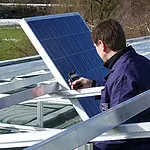Radioactivity meter with integrated sensor, determines the energy yield of solar systems /
also serves to find optimal solar locations for new systems
The radioactivity meter for solar energy is the optimal hand - testing device for solar engineers, architects and hobby solar installers. With this solar meter you determine the solar power. This makes it possible to make a statement about the composition and design of a photovoltaic system. The light intensity is measured using a monocrystalline silicon solar cell. The processor integrated in the solar measuring device ensures automatic correction to maintain the basic accuracy after the calibration of each device in the solar simulator. The most important parameter P tot (in W/m²) can be read directly on the display.
The data contained in the internal memory (32,000 measured values) can be transferred to the serial interface of a PC using the software. This radioactivity meter was also designed for outdoor use and has a weather-resistant plastic housing. Its compact dimensions allow convenient one-hand operation.
1. Solar - direct measurement on site
With the solar measuring device, a direct measurement of the energy can be made at a defined position. These measured values can e.g. used to check the efficiency of PV modules or solar thermal systems.
2. Simulation of temperature, power, voltage and current of PV modules
Attention: only possible in combination with the multimeter we offer.
3. Long-term measurements
The solar measuring device is equipped with an internal data logger for measurements over longer periods of time.
Solar radiation
The radioactivity meter detects the full solar radiation, i.e. both the direct radiation and the diffuse solar radiation of the atmosphere. Most of the energy from the sun's rays that reflects off the surface of the earth is in the infrared-visible band of the spectrum because the ultraviolet radiation is absorbed by the atmosphere. Solar radiation varies throughout the year because the angle of the incoming light rays is greater in summer than in winter and the rays are more perpendicular in summer.





